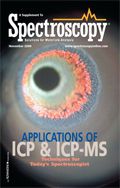The Research Behind the Headlines
Special Issues
Editor letter on ICP and ICP-MS
Safer drinking water. Lead paint in toys. Cleaner-burning gasoline. These could be the headlines on your favorite website on any given day of the week, as each of these issues has captured the attention of the media and the world at large in recent years. They've affected the daily lives of each and every one of us at some point, whether we fished through our children's toys after the most recent lead paint scare, or boiled water like many in New York City did during a recent contamination.
However, these life-affecting issues have one more important thing in common, and that is the fact that they are covered here in the November 2009 edition of Spectroscopy's annual ICP/ICP-MS supplement. Disseminating research that makes the world a better place has long been at the core of Spectroscopy's editorial mission, and there may be no better example of this than the supplement you are now reading. Here you will find practical, real-world examples of spectroscopy improving — and even saving — lives. For many of us, when a law is passed mandating lower levels of toxins in drinking water or cleaner-burning gasoline, we assume it just happens overnight. But here in this supplement, you will find the actual research behind the headlines, and see the everyday work that must be done once laws are enacted and regulations passed.
As always, we hope you enjoy this supplement and find it useful in your everyday work. We are proud to bring you this research from the front lines of materials analysis, and perhaps the next time our nightly cable news programs bring us a breaking story on a lead paint scare, or contaminated drinking water, or legislation aimed at reducing emissions, we will remember these individuals doing the real-world research that makes the world a better place.
David Walsh
Editor-in-Chief

LIBS Illuminates the Hidden Health Risks of Indoor Welding and Soldering
April 23rd 2025A new dual-spectroscopy approach reveals real-time pollution threats in indoor workspaces. Chinese researchers have pioneered the use of laser-induced breakdown spectroscopy (LIBS) and aerosol mass spectrometry to uncover and monitor harmful heavy metal and dust emissions from soldering and welding in real-time. These complementary tools offer a fast, accurate means to evaluate air quality threats in industrial and indoor environments—where people spend most of their time.
NIR Spectroscopy Explored as Sustainable Approach to Detecting Bovine Mastitis
April 23rd 2025A new study published in Applied Food Research demonstrates that near-infrared spectroscopy (NIRS) can effectively detect subclinical bovine mastitis in milk, offering a fast, non-invasive method to guide targeted antibiotic treatment and support sustainable dairy practices.
Smarter Sensors, Cleaner Earth Using AI and IoT for Pollution Monitoring
April 22nd 2025A global research team has detailed how smart sensors, artificial intelligence (AI), machine learning, and Internet of Things (IoT) technologies are transforming the detection and management of environmental pollutants. Their comprehensive review highlights how spectroscopy and sensor networks are now key tools in real-time pollution tracking.